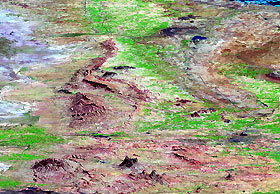
Save this image free of charge
in 800 pixels for layout use
(right click, Save as...)
|
|
Ref : V01843
Theme :
Looking at Earth - Cities (375 images)
Title : Perspective View with Landsat Overlay: Bhuj and Anjar, India
Caption :
This perspective view shows the city of Bhuj, India, in the foreground near the right side (dark gray area). Bhuj and many other towns and cities nearby were almost completely destroyed by the January 26, 2001, earthquake in western India. This magnitude 7.6 earthquake was the deadliest in the history of India with some 20,000 fatalities and over a million homes damaged or destroyed. The epicenter of the earthquake was in the area in the upper left corner of this view.The city of Anjar is in the dark gray area near the top center of the image. Anjar was previously damaged by a magnitude 6.1 earthquake in 1956 that killed 152 people and suffered again in the larger 2001 earthquake. The red hills to the left of the center of the image are the Has and Karo Hills, which reach up to 300 meter (900 feet) elevation. These hills are formed by folded red sandstone layers. Geologists are studying these folded layers to determine if they are related to the fault that broke in the 2001 earthquake. The city of Bhuj was the historical capital of the Kachchh region. Highways and rivers appear as dark lines. Vegetation appears bright green in this false-color Landsat image. The Gulf of Kachchh (or Kutch) is the blue area in the upper right corner of the image, and the gray area on the left side of the image is called the Banni plains.This three-dimensional perspective view was generated using topographic data from the Shuttle Radar Topography Mission (SRTM) and an enhanced false-color Landsat 7 satellite image. Colors are from Landsat bands 5, 4, and 2 as red, green and blue, respectively. Topographic expression is exaggerated 5X.Landsat has been providing visible and infrared views of the Earth since 1972. SRTM elevation data matches the 30-meter resolution of most Landsat images and will substantially help in analyses of the large and growing Landsat image archive. Elevation data used in this image was acquired by the Shuttle Radar Topography Mission (SRTM) aboard the Space Shuttle Endeavour, launched on February 11, 2000. SRTM used the same radar instrument that comprised the Spaceborne Imaging Radar-C/X-Band Synthetic Aperture Radar (SIR-C/X-SAR) that flew twice on the Space Shuttle Endeavour in 1994. SRTM was designed to collect three-dimensional measurements of the Earth's surface. To collect the 3-D data, engineers added a 60-meter-long (200-foot) mast, installed additional C-band and X-band antennas, and improved tracking and navigation devices. The mission is a cooperative project between the National Aeronautics and Space Administration (NASA), the National Imagery and Mapping Agency (NIMA) of the U.S. Department of Defense (DoD), and the German and Italian space agencies. It is managed by NASA's Jet Propulsion Laboratory, Pasadena, CA, for NASA's Earth Science Enterprise, Washington, DC.Size: scale varies in this perspective image Location: 23.4 deg. North lat., 69.8 deg. East lon.Orientation: looking East Image Data: Landsat Bands 5, 4, 3 as red, green, blue respectively Original Data Resolution: SRTM 30 meters (99 feet) Date Acquired: four days in February, 2000 (SRTM), February 9, 2001 (Landsat)
|
|

